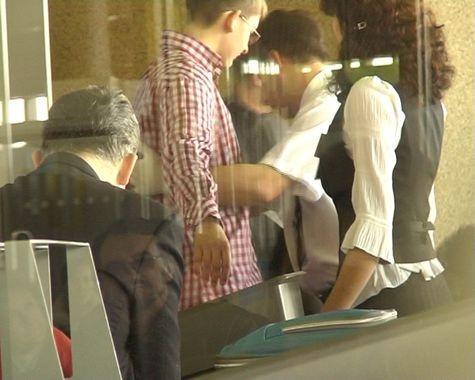
New York
I Dream of the Stans
Winkleman Gallery
March 20–April 26, 2008
At first glance, ‘I Dream of the Stans’ appeared to be a compelling exploration of virgin cultural territory — one that stretches seductively across China, Russia, and Iran and counts the politics of Islam and the Soviet Union’s legacy among its complicated assets. Just as the economic prosperity of the New Silk Road has cemented the independence of former Soviet states, the internationalization of the art world has given their artists unprecedented access to platforms and markets.
Officially, the trend kicked off with the Venice Biennale’s Central Asian Pavilion in 2005 and continued last year in New York with the gallery show ‘The Paradox of Polarity’ at Bose Pacia. Then came ‘I Dream of the Stans,’ curated by Leeza Ahmady, Murat Orozobekov, and Edward Winkleman.
While most of the seven videos in the exhibition were displayed on monitors, Said Atabekov’s Neon Paradise (2003) was projected large against the gallery wall. In the piece, a shaman-like figure repeatedly bowed to an impersonal modern building, whose glass doors slid open and closed in response. The Kazakh artist baited the modernist structure, using props like his pointy hat and Soviet water jug to add to the absurdity of the ritual. The video lent portability and posterity to his performance, but there wasn’t much to be grasped once the tradition-meets-modernity premise was established. Vyacheslav Akhunov’s Cleaner (2007) was likewise caught up in absurd (and prolonged) rituals: the video documented the veteran Uzbek artist undertaking a “pilgrimage to the United Kingdom” to polish monuments with a toothbrush.
Not all of the artists treated global heritage so gingerly or with so little visual interest. In Rustam Khalfin and Julia Tikhonova’s video projection Love Races (2001), a naked couple documented themselves with a shaky handheld camera as they made love on the back of a horse — an admirable balancing act, whichever way you look at it. The work updated the soft-porn appeal of nineteenth-century illustrations, only this time it was the protagonists who recorded the scenes.
Almagul Menlibayeva upped the ante and gave ethno-glamour a catchier title. Jihad (2004), filmed within the mausoleum of Turkic saint Ahmad Yasavi, showed the artist writhing and struggling with vivid swaths of fabric, rubbing herself against the walls with a savage relish that would have put Andrea Fraser to shame. The exception, of course, was that Menlibayeva’s wild diva wasn’t critiquing the institution but celebrating its ornate, photogenic glory. Was this a subversive reworking of a politicized term or a narcissistic restaging of Orientalist kitsch? It was tempting to assume the latter.
Rahraw Omarzad’s Opening (2005) was just as visually pleasing and politically noncommittal but posed its dilemma with greater stylistic restraint. A shy peek from beneath a veil raised the usual cliché expectations vis-à-vis the female gaze. But once scissors cut into the fabric, a hand emerged and embroidered flower motifs around the hole. Again it was hard to decide if the work affirmed the tarnished history of, say, Muslim women’s rights in Afghanistan, or if its ambitions were more decorative.
Capitalizing on the lack of knowledge in the West about the region, ‘I Dream of the Stans’ reproduced the allure of Central Asian-ness that gets curators and artists equally excited. Given the years of austerity imposed on those states, the return of ethnic, mystical, and regional identities should be understandable, even liberating. What’s wrong with mausoleum erotica, cultural mythologizing, and ethnic exhibitions embroidery?
Despite their quirky collective name, the Stans aren’t an imagined locus of dreams. They are complex societies sitting atop profitable energy resources. Autocratic rulers have embraced the ethnic turn as national policy, commissioning tourist brochures as they barter with past and present superpowers. In these circumstances, identity-centered aesthetics come worryingly close to late-capitalist propaganda; actual social conditions are swept under the rug while artists and curators enjoy their ambassadorial status.
Of course, not all the artists consulted their inner shaman. Some approached the landscape of cultural representation more directly. Jamshed Khalilov’s Bus Stop (2006) articulated the very framing device of the exhibition with a slide show of photographs showing Tajik bus stops built in bizarre styles — Soviet, Islamic, and so on. Like the exhibition’s curators, Khalilov had an eye for surreal hybridity but was more straightforward about his own role in appropriating and decontextualizing what he found. Gulnara Kasmalieva and Muratbek Djumaliev also gave the exhibition a more sober and reflective touch. In Something About Contemporary Nomadism (2006), the artists snuck a camera into an airport to film banal scenes of security searches. Nomadism was appropriated not for picturesque pathos but for relevance as a metaphor — and a refreshingly pessimistic one, at that.
Taken together, the seven videos were less about dreams of place than about narratives — and products — of globalization. Most of the artists continue to live and work in Central Asia, and all are prominent figures in their emerging art scenes — running art spaces or teaching university courses. Concerned with the forces shaping their histories and realities, they’re also aware of the market for savvy, self-styled cultural representatives. And that awareness often overwhelmed the work in this show, resulting in digestible binaries and celebrations of alterity. One couldn’t help but suspect that the artists were capable of more.